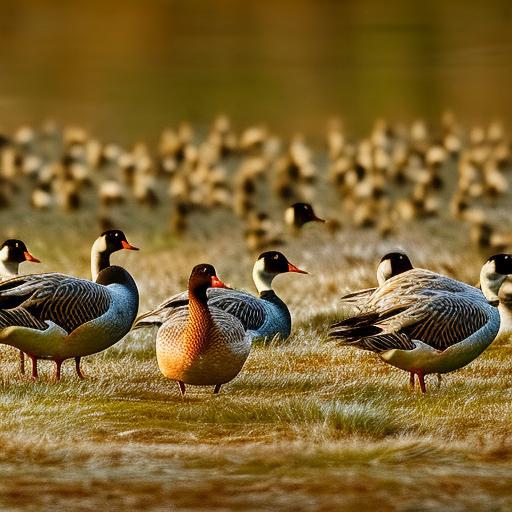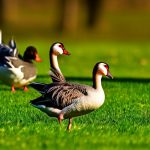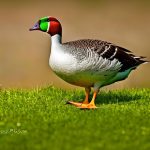Geese control is an important aspect of maintaining the cleanliness and safety of public spaces. Geese are known to leave behind droppings that can be unsightly and unsanitary, especially in parks, golf courses, and other recreational areas. Additionally, geese can become aggressive during nesting season, posing a threat to humans and other animals. Therefore, it is crucial to implement effective geese control methods to ensure the well-being of both humans and the geese themselves.
There are several methods of geese control that can be employed depending on the specific situation. These methods range from natural deterrents and scare tactics to physical barriers and electronic devices. Each method has its own advantages and effectiveness, and it is important to understand the behavior of geese in order to choose the most appropriate method for a particular situation.
Key Takeaways
- Geese can cause damage to property and pose health risks, making geese control necessary.
- Understanding geese behavior is important in developing effective control strategies.
- Natural deterrents like landscaping and decoys can help discourage geese from settling in an area.
- Scare tactics like noise makers and trained dogs can be effective in keeping geese away.
- Physical barriers like fencing and netting can prevent geese from accessing an area.
Understanding the Behavior of Geese
Geese are attracted to certain areas due to a variety of factors. They are social animals that prefer open spaces near water sources, such as ponds, lakes, and rivers. These areas provide them with ample food sources, nesting sites, and protection from predators. Geese also have a strong homing instinct and tend to return to the same location year after year.
Understanding the behavior of geese can help in controlling them effectively. For example, geese are more likely to stay in an area if they find it comfortable and safe. By modifying the habitat to make it less appealing to geese, such as removing tall grasses or installing fencing around water sources, their presence can be discouraged. Additionally, knowing when geese are most likely to be aggressive, such as during nesting season, can help in implementing scare tactics or physical barriers during those times.
Natural Deterrents for Geese
There are several natural deterrents that can be used to keep geese away from certain areas. One effective method is the use of dogs trained to chase geese. The presence of a dog can create a sense of danger for the geese, causing them to avoid the area. Another natural deterrent is the use of certain plants that geese find unappealing. For example, planting tall grasses or shrubs with thorny branches can discourage geese from landing and staying in an area.
These natural deterrents work by creating an environment that is uncomfortable or unsafe for geese. Dogs are seen as predators by geese, and their presence can trigger their instinct to flee. Similarly, plants with thorny branches or tall grasses make it difficult for geese to navigate and find suitable nesting sites or food sources. By using these natural deterrents, geese can be effectively kept away from certain areas without causing harm to them.
The Role of Scare Tactics in Geese Control
Scare tactics are another effective method of geese control. These tactics involve creating a sense of danger or threat for the geese, causing them to avoid the area. One common scare tactic is the use of decoy predators, such as plastic owls or coyotes. These decoys mimic natural predators of geese and can deter them from landing and staying in an area.
Another scare tactic is the use of noise-making devices, such as propane cannons or air horns. These devices produce loud noises that startle the geese and make them feel unsafe. By consistently using these scare tactics, geese can be conditioned to associate certain areas with danger and avoid them altogether.
Scare tactics can be effective because they exploit the natural instincts of geese to avoid potential threats. Geese are wary animals that rely on their senses to detect danger. By creating a sense of danger through the use of decoy predators or loud noises, geese can be effectively deterred from certain areas.
Physical Barriers to Keep Geese Away
Physical barriers are another effective method of geese control. These barriers physically prevent geese from accessing certain areas, such as ponds or lawns. One common physical barrier is the use of fencing or netting around water sources. This prevents geese from landing and accessing the water, forcing them to find alternative locations.
Another physical barrier is the use of low-growing plants or shrubs to create a visual barrier. Geese rely on their vision to detect potential threats, and by obstructing their line of sight, they can be deterred from landing and staying in an area.
Physical barriers can be installed and maintained relatively easily. Fencing or netting can be installed around water sources, and low-growing plants or shrubs can be planted strategically to create a visual barrier. Regular maintenance is required to ensure that the barriers remain effective and intact.
Electronic Devices for Geese Control

Electronic devices are another method of geese control that can be effective in certain situations. These devices emit sounds or lights that are unpleasant or threatening to geese, causing them to avoid the area. One common electronic device is the use of sonic repellers that emit distress calls or predator sounds. These sounds mimic natural threats to geese and can effectively deter them from landing and staying in an area.
Another electronic device is the use of laser lights that create a visual deterrent for geese. These lights create a sense of danger for the geese, causing them to avoid the area.
Electronic devices can be effective because they exploit the natural instincts of geese to avoid potential threats. By emitting sounds or lights that mimic natural predators or distress signals, geese can be effectively deterred from certain areas.
The Use of Repellents in Geese Control
Repellents are another method of geese control that can be effective in certain situations. These repellents create an unpleasant or unsafe environment for geese, causing them to avoid the area. One common repellent is the use of taste aversion products that make the grass or vegetation in an area unpalatable to geese. These products are applied to the grass or vegetation and are safe for both humans and geese.
Another repellent is the use of visual deterrents, such as reflective tape or scare-eye balloons. These visual deterrents create a sense of danger for the geese and can effectively deter them from landing and staying in an area.
Repellents can be effective because they create an environment that is unappealing or unsafe for geese. By making the grass or vegetation unpalatable or creating a visual deterrent, geese can be effectively deterred from certain areas.
Habitat Modification to Discourage Geese
Modifying the habitat is another effective method of geese control. By making certain areas less appealing to geese, their presence can be discouraged. One common method of habitat modification is the removal of tall grasses or shrubs near water sources. Geese prefer open spaces where they can easily detect potential threats, and by removing tall grasses or shrubs, their line of sight is obstructed, making them feel unsafe.
Another method of habitat modification is the installation of fencing or netting around water sources. This prevents geese from accessing the water and forces them to find alternative locations.
Habitat modification can be effective because it creates an environment that is less appealing or unsafe for geese. By removing tall grasses or shrubs or installing fencing or netting, geese can be effectively deterred from certain areas.
Professional Geese Control Services
Hiring professional geese control services can be beneficial for long-term geese control. These services have the expertise and experience to implement effective geese control methods and provide ongoing maintenance and monitoring. They can assess the specific needs of a particular area and recommend the most appropriate methods for geese control.
Professional geese control services can also provide education and training to property owners or managers on how to effectively implement and maintain geese control methods. They can also provide regular monitoring and maintenance to ensure that the methods remain effective over time.
By hiring professional geese control services, property owners or managers can ensure that geese control is implemented effectively and maintained in the long term.
Best Practices for Long-Term Geese Control
To maintain long-term geese control, it is important to implement best practices. Regular monitoring and maintenance of geese control methods is crucial to ensure their effectiveness over time. This includes checking and repairing physical barriers, replenishing repellents or deterrents, and adjusting scare tactics or electronic devices as needed.
It is also important to stay updated on the latest geese control methods and technologies. Geese behavior and preferences may change over time, and new methods may be developed that are more effective in deterring geese from certain areas.
Additionally, it is important to educate the public on the importance of geese control and encourage their participation in maintaining clean and safe public spaces. This can be done through signage, educational materials, or community outreach programs.
Geese control is an important aspect of maintaining clean and safe public spaces. By understanding the behavior of geese and implementing effective geese control methods, their presence can be effectively deterred from certain areas. Natural deterrents, scare tactics, physical barriers, electronic devices, repellents, habitat modification, and professional geese control services are all effective methods that can be used depending on the specific situation.
It is important to implement best practices for long-term geese control, including regular monitoring and maintenance of geese control methods and staying updated on the latest technologies. By taking action in controlling geese in their area, property owners or managers can ensure the cleanliness and safety of public spaces for both humans and geese.
If you’re looking for ways to keep geese away from your property, you might also be interested in learning about the incubation period for goose eggs. Understanding this crucial aspect of breeding geese can help you better manage their population and prevent unwanted nesting. Check out this informative article on Poultry Wizard to gain valuable insights into the incubation process and how it can be used as a tool for geese control.
FAQs
What are some effective ways to keep geese away?
Some effective ways to keep geese away include using decoys, installing fencing or netting, using noise deterrents, and applying repellents.
What are some natural repellents that can be used to keep geese away?
Some natural repellents that can be used to keep geese away include planting certain types of vegetation, such as tall grasses or prickly bushes, and using essential oils, such as peppermint or grapefruit.
Why is it important to keep geese away?
It is important to keep geese away because they can cause damage to property, create unsanitary conditions, and pose a safety risk to humans, particularly in areas where they may become aggressive during nesting season.
What are some common areas where geese may be a problem?
Geese may be a problem in areas such as parks, golf courses, residential neighborhoods, and commercial properties with large lawns or bodies of water.
Are there any laws or regulations regarding the removal of geese?
Yes, there are laws and regulations regarding the removal of geese, particularly in regards to migratory birds. It is important to check with local and federal authorities before taking any action to remove geese.
Meet Walter, the feathered-friend fanatic of Florida! Nestled in the sunshine state, Walter struts through life with his feathered companions, clucking his way to happiness. With a coop that’s fancier than a five-star hotel, he’s the Don Juan of the chicken world. When he’s not teaching his hens to do the cha-cha, you’ll find him in a heated debate with his prized rooster, Sir Clucks-a-Lot. Walter’s poultry passion is no yolk; he’s the sunny-side-up guy you never knew you needed in your flock of friends!







